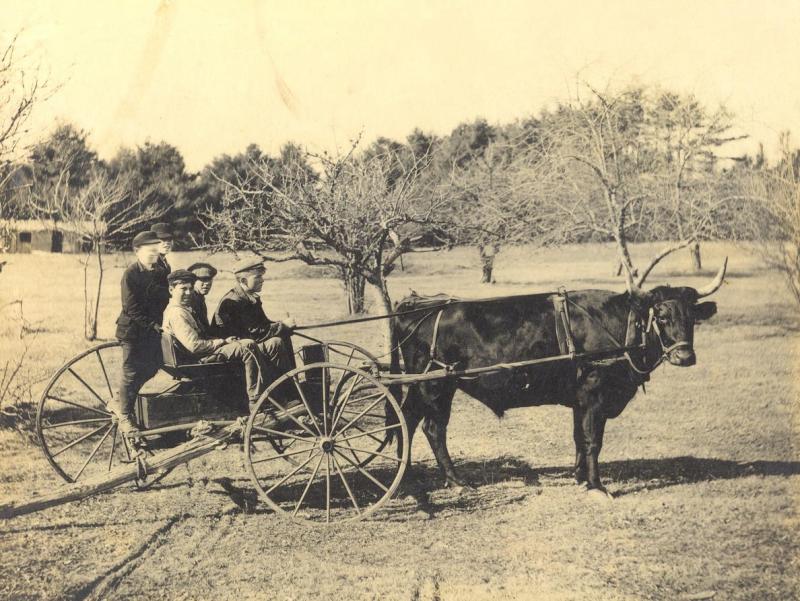Cows, daffodils, chicken glasses: Rochester's unique farming history
Why did the chicken wear a pair of glasses?
It may sound like yet another chicken riddle, but in the days of yesteryear, a chicken sporting some fashionable eyewear was a common sight in Rochester.
A pair of the silver frames were on display at the Rochester Historical Society on September 29, as part of the society's latest exhibit, "The History of Farming in Rochester."
Historical Society Treasurer Betty Beaulieu explained that the poultry fashion statement had less to do with the chickens' vision, and more with their sharp beaks. "If they wore those, they couldn't peck the other chickens!"
The exhibit is full of interesting and unique information on Rochester's history, from immigrants to gentlemen, and dairy cows to alpacas and even daffodils.
Pig Killer Hill—Ryder Road
Startling name aside, Pig Killer Hill was actually an important site in early Rochester. Every fall, a butcher would set up shop on the hill. Farmers would herd their pigs to the hill to process them before the winter.
Pigs from what is now the tri-town, Freetown, Lakeville, Acushnet and New Bedford were all slaughtered on the hill.
It is not known exactly where the hill was, as it has long since been flattened and mined for sand. Early topographical maps show it as nearly 100 feet high and in the vicinity of Connet Woods and the cranberry bogs currently on Ryder Road.
The origins of 'Walnut Plain Road'
Farmers and families bringing their pigs to slaughter at Pig Killer Hill often let them rest and fatten themselves up for a week before bringing them to the hill. A nearby area of Rochester, where the pigs were left to graze, was rich with walnuts, pignuts, oak trees, shagbark, hickory, bitternuts and more. It is no surprise to learn that the road which ran near the area became known as Walnut Plain, for the plenty it offered.
Humphrey Farm, or the Rochester Golf Course
In earlier years, the lush greenery of the Rochester Golf Course was home to a sheep farm. There was a windmill on the farm's property, and lambs were kept in pens on either side of the road. Some of the fields on the opposite side of the road (in what is now the large triangular field running inside Vaughan Hill and Rounseville Roads and Bowens Lane) also belonged to the farm.
White's Dairy—Vaughan Hill Road
The dairy barn atop a hill near the Rochester Grange is a well-known landmark in the town. While these days the barn is the home of Jonathan Sprouts and the fields grow produce, in the 1950s, the barn was the central point of White's Dairy Farm.
Raymond White, the owner of several dairies in Rochester, Freetown, and Acushnet, bought the property in 1951. He kept 50 dairy cows on the property.
These days, the large triangular field between Bowen's Lane and Rounseville Road is home to various crops and a cranberry bog. In the 1950s, the field grew corn for the cows. The hay that fed them was grown at the old Rochester Airport property on Route 105; now the future site of Rochester Farms.
Pine Crest Farm - 125 Vaughan Hill Road
Pine Crest Farm is still in operation today, as a family farm owned by Peter and Caroline McGregor. William (Bill) McGregor owned the farm from 1918-1981. As the years wore on and McGregor slowly went blind, the exhibit noted that his son John rigged up ropes so that his father could still reach the barn and the garage.
Asparagus planted in the 1920s and 1930s still grows on the property.
Johnson Poultry Farm— 462 New Bedford Road
Swedish immigrant Gustaf Johnson arrived in the USA in 1927. After many years of working in plant nurseries, he and his wife purchased property on New Bedford Road in 1938.
On the property, they planted 29,000 daffodil bulbs. The flowers were sold to florists in New Bedford and Boston.
To check out more interesting local history, visit the Rochester Historical Society at 355 County Road, in the old East Rochester Church. The museum will be open from 1-3 p.m. every Sunday in October.















